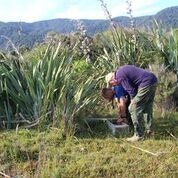Pest traps reset at Martins Bay
Lucy Henry
21 May 2020, 2:22 AM
 Predator control has been able to restart at a valuable "mainland island sanctuary" for the first time since lockdown.
Predator control has been able to restart at a valuable "mainland island sanctuary" for the first time since lockdown.The Hollyford Conservation Trust was able to send contractors into Martins Bay this week for the first time since the lockdown, enabling the resetting of more than 386 stoat traps on the "mainland island sanctuary” that are vital for keeping pest levels low so that native birds can thrive.
Hollyford Conservation Trust Manager Vanessa Horwell said she was very concerned that workers had been delayed in resetting the traps as this could be having drastic effects on the native birdlife.
"A whole season’s work or more could be unravelled, with birds being predated on by high numbers of stoats."
Since 2014, the trust has been operating a "landscape-scale Ecological Restoration Project" in the Lower Hollyford Valley which Mrs Horwell said aimed to create a "sanctuary for wildlife without a fence", by undertaking intensive pest control.
Before the project started, Mrs Horwell said the area was "overrun with possums, rats and stoats", but now the native birdlife is reported to be some of the best on mainland New Zealand.
The results from the latest annual bird survey were recently finalised and found that bellbird densities had skyrocketed since predator control started in the area; with estimated densities increased from 1.2 bellbirds per hectare in 2014 to 6.1 bellbirds per hectare in 2019. Encounter rates for the five key forest bird species monitored had nearly doubled between 2014 and 2019.
Mainly Fauna, which conducted the survey on behalf of the HCT, reported that the bellbird density at Martins Bay was higher than at any of the other sites it had surveyed throughout the South Island.
Rifleman were rare at Martins Bay when the first bird surveys were first undertaken in 2014 but now their densities had increased significantly.
Other native species such as Tui, Kereru, Kaka and Kakariki had also become a lot more abundant.
Mrs Horwell said the reason for this, and why the project was so special, was because of the ecological diversity and abundance of food in the area.
The forest is rich with a large variety of tree species such as Rata, Kowhai and Rimu, which provide an excellent array of food year-round, so the forest is able to support a much higher density of birds than other less diverse forests in other areas.
However, this also means that rats and other pests, such as rats and stoats, can explode in the area.
This issue was made worse after last autumn's mega mast where trees and other plants produced exceptionally high amounts of seed.
This over-supply of seeding provides a "bonanza" of food for native species but also fuels rodent and stoat numbers that pose a serious threat to native birds and other wildlife.
To give some perspective, there are 386 stoat traps and 2000 bait stations set across the 2600 hectares of project area in Martin’s Bay.
In February, the HCT caught 65 stoats in traps, which Mrs Horwell said was more than the team had ever caught before.
"Last year the average catch rate was 3% but in February it was 17.5%," she said.
The stoat traps also needed to be reset eight times a year.
Events such as the February floods, which wiped out a lot of traps and tracking tunnels in the area, and now restrictions from COVID-19 make the job all the harder.
However, the Hollyford Conservation Trust said with the challenges there also comes “opportunities to come out the other side stronger and better prepared than before”.

Hollyford Conservation Trust chairman Ron Anderson and trustee Michael Pullar check a stoat trap.
AG | TRADES & SUPPLIES


